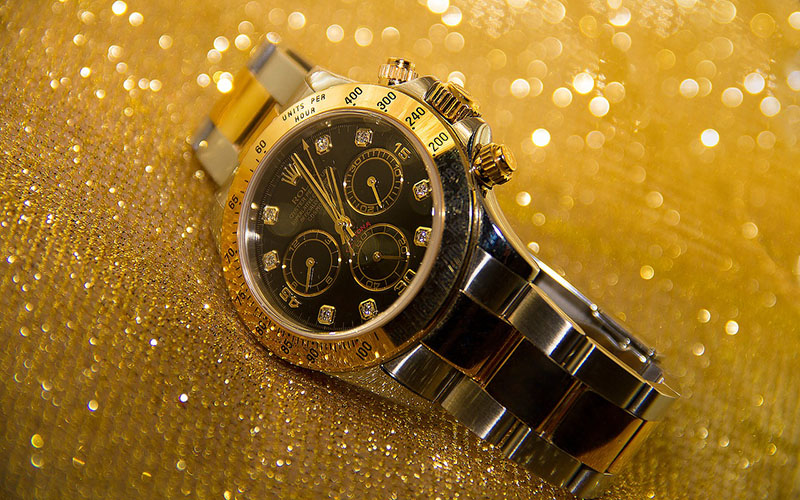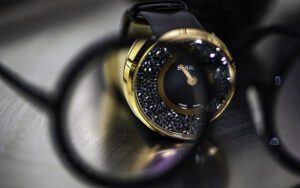Supply chain shortages, increased prices on everything from food to fuel, and new variants of the COVID-19 virus. If 2022 financial forecasts are correct, we’re on track to see inflation soar to the highest annual rate since 1991. Now is not the time to raid some of your hard-earned savings to buy a luxury watch.

Or is it?
When the economy sputters, and inflation’s on the rise, people often look to invest in other items with intrinsic value like gold or fine art. Gold and art are scarce assets and more likely to hold their value or even appreciate over time. They also are not directly affected by changing interest rates or currency fluctuations, thus making them impervious to inflation.
Certain luxury watches like Rolex, Richard Mille, Patek Philippe, and others fall into that same category of items with intrinsic worth. And unlike gold bars or art, you can wear your investment daily and still expect to fetch a good price for it later. You get to spoil yourself, look classy, and have a solid investment—all at once. Definitely a win-win-win.
You’re probably not a Drake who can afford a $750,000 piece of wrist candy from Richard Mille. So how can you diversify your investment portfolio to include a luxury watch without going broke? Our Swiss-trained watch repair experts have been in this business a long time and have three key suggestions to get you started.
1. Stay with the Brands Known for Retaining Value
You can’t go wrong with these four brands: Richard Mille, Patek Philippe, Rolex, and Audemars Piguet. That’s not to say other biggies out there, like Omega, Cartier, or Zenith should be ignored. But in the latter half of 2021, certain Audemars, Patek, and Rolex watches significantly outperformed other brands, increasing overall value by about 67 percent, 49 percent, and 39 percent respectively, according to WatchCharts.
You don’t have to be a rock star or world-famous athlete to afford a Rolex or Patek Philippe, either. While a Richard Mille watch may be out of your investment budget (new and used ones cost into the hundreds of thousands of dollars), you can pick up a new Rolex Oyster Perpetual Date for under $4,000 or a nice Patek Philippe or Audemars Piguet for between $10,000 and $20,000.
2. Only Buy from Reputable Sources and Do Your Homework
Watch collectors and investors have plenty of forums from which to choose when selecting a timepiece, from sales and auction sites like eBay and Amazon to authorized dealers, private owners, retailers, and auction houses. Each of these different venues has pros and cons. For example, buying from an authorized dealer probably won’t get you the best price, but it will offer a guaranteed warranty and watch servicing with authentic parts. On the other hand, finding a seller on a watch forum may score a great price but little to no warranty or servicing.
Before you move further with any seller, it’s good to check their ratings and reviews and see how much experience they have in the business. Does their name pop up in watch forums as a trusted seller? Do they have an authenticity guarantee, so you’re protected if the watch is fake. The eBay Authenticate Program, for example, gives buyers a money-back guarantee for more than 30 watch brands.
If you’re buying online, ask for pictures of the watch from every angle. Blurry photos—or not enough photos—of all the details is a big red flag. Study the pictures carefully for dents, scratches or other cosmetic damage that seems more serious than normal wear and tear. Other things to look for are inconsistencies in the letters and numerals on the face, rough or unfinished edges, lighter weight, or a ridiculously discounted price. Someone with a real Patek or Audemars will know that these watches hold their value, so if the item’s price is ‘too good to be true,’ it most likely is.
Finally, does the seller have the original packaging and authenticity paperwork? Not only do these items help establish authenticity, but they also indicate that the watch is a valued possession. Note, not having the paperwork or packaging shouldn’t necessarily be a dealbreaker. Sellers may not always have these items, especially if that particular vintage watch you’re buying has been buried in a box in someone’s attic for 50 years.
3. Plan for Future Care and Repair
Finding a suitable place for your Patek repair is just as critical as finding the watch itself. A few seconds ago, we talked about warranties. These can be tricky, so it’s important to read the fine print. How long does the seller agree to service your watch, and what exactly is covered? Will they only use authentic parts? If your watch is an older model, what will they do if they can’t find the parts? Do they have an established mail-in service if you’re not nearby? How long do they take to complete servicing or repairs?
And perhaps most importantly, what are the seller’s repair ratings? Do they have a long track record of satisfied customers or an endless list of complaints? If the latter’s the case, it makes no sense to pay extra for a warranty you won’t want to use. The moral of the story here is that the place that sold you your timepiece isn’t always the best place to have it serviced.
Look around, read reviews, talk to people on the watch forums. Once you find a service you really like, plan to stick with them. This way, you’ll always have someone who knows you and your watch exceptionally well—kind of like your mechanic or your doctor.




